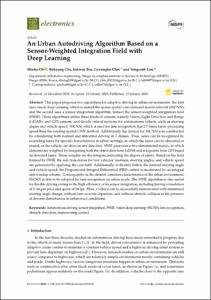Interdisciplinary Engineering Major
Advanced Intelligent Mobility Research Group
1. Journal Articles
An Urban Autodriving Algorithm Based on a Sensor-Weighted Integration Field with Deep Learning
- Title
- An Urban Autodriving Algorithm Based on a Sensor-Weighted Integration Field with Deep Learning
- Author(s)
- Oh, Minho ; Cha, Bokyung ; Bae, Inhwan ; Choi, Gyeungho ; Lim, Yongseob
- Issued Date
- 2020-01
- Citation
- Electronics, v.9, no.1
- Type
- Article
- Author Keywords
- autonomous driving ; sensor integration ; SWIF ; vision deep learning ; SSCNN ; lane recognition ; obstacle detection ; maneuvering control
- Keywords
- VEHICLE
- ISSN
- 2079-9292
- Abstract
- This paper proposes two algorithms for adaptive driving in urban environments: The first uses vision deep learning, which is named the sparse spatial convolutional neural network (SSCNN); and the second uses a sensor integration algorithm, named the sensor-weighted integration field (SWIF). These algorithms utilize three kinds of sensors, namely vision, Light Detection and Range (LiDAR), and GPS sensors, and decide critical motions for autonomous vehicle, such as steering angles and vehicle speed. SSCNN, which is used for lane recognition, has 2.7 times faster processing speed than the existing spatial CNN method. Additionally, the dataset for SSCNN was constructed by considering both normal and abnormal driving in 7 classes. Thus, lanes can be recognized by extending lanes for special characteristics in urban settings, in which the lanes can be obscured or erased, or the vehicle can drive in any direction. SWIF generates a two-dimensional matrix, in which elements are weighted by integrating both the object data from LiDAR and waypoints from GPS based on detected lanes. These weights are the integers, indicating the degree of safety. Based on the field formed by SWIF, the safe trajectories for two vehicles’ motions, steering angles, and vehicle speed are generated by applying the cost field. Additionally, to flexibly follow the desired steering angle and vehicle speed, the Proportional-Integral-Differential (PID) control is moderated by an integral anti-windup scheme. Consequently, as the dataset considers characteristics of the urban environment, SSCNN is able to be adopted for lane recognition on urban roads. The SWIF algorithm is also useful for flexible driving owing to the high efficiency of its sensor integration, including having a resolution of 2 cm per pixel and speed of 24 fps. Thus, a vehicle can be successfully maneuvered with minimized steering angle change, without lane or route departure, and without obstacle collision in the presence of diverse disturbances in urban road conditions. © 2020 by the authors. Licensee MDPI, Basel, Switzerland.
- Publisher
- MDPI
- Related Researcher
-
-
Choi, Gyeungho
- Research Interests ADAS; Automated Driving System; Clean Gas Energy Technology; Air Pollution Control Technology
-
- Files in This Item:
-
 기타 데이터 / 8.66 MB / Adobe PDF
download
기타 데이터 / 8.66 MB / Adobe PDF
download



